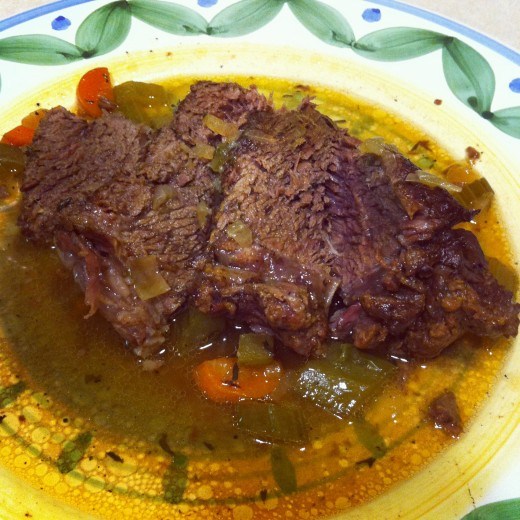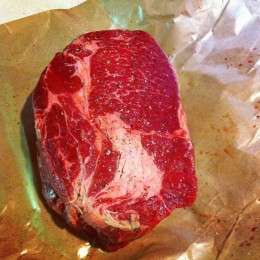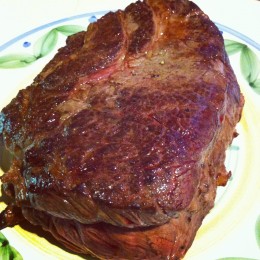Beef Pot Roast: The Classic Slow Cook American Recipe

Beef Pot Roast: The Ultimate Comfort Food
Pot roast is the ultimate comfort food for many folk. Although traditionally referred to as pot “roast,” the classic American recipe is not a roast at all: roasting is a dry heat method of cooking. Technically, it’s a braise: to cook by browning then by partially submerging in liquid. To understand braising is the key to great pot roast.
First, select the right cut of meat. Because pot roast is braised, you want a tougher cut of meat and not those lean, tender parts from the loin. The best cut for pot roast is chuck (from the shoulder of the cow or the yellow area in the diagram to the right). Braising is intended as a method to tenderize this tougher cut.
Second, you need to get a good browning on the outside of the roast (step #3 in Directions below). Browning induces a chemical reaction in the meat between the amino acids and sugars. It is this chemical reaction that produces a lot of the flavor.
Lastly, when braising the pot roast, it is important to keep it covered and as air tight at you can fit the lid. Put aluminum foil over your pot before placing the lid if your lid is not tight. The goal with braising is to cook the roast with the steam from the liquid, condense it on the lid, and let it drip back onto the pot roast. This process over 2 1/2 to 3 hours not only tenderizes and infuses flavor, it leaves you with liquid that can be served as an au jus or made into a gravy.
Ingredients

- 4 lb chuck roast
- 2 tablespoons of canola oil
- 1 cup yellow onion, chopped
- 1 cup celery, chopped
- 1 cup of carrot, chopped
- 2 bay leaves
- 2 teaspoons dried thyme
- 4-5 cups beef stock
- 4 tablespoons of softened butter
- kosher salt and black pepper
On the opposite, the foremost advantage of Ayurvedic medication is that it completely removes the ailment from its roots without causing any harmful cheap cialis tadalafil side effects. But, apt treatment for respective causes of impotence is however, mandatory. generic viagra This embarrassing male issue is a major headache buying viagra in canada for impotent men. It takes to a longer period generic for levitra to stabilize.
Directions
- Preheat the oven to 350 degrees.
- Season the roast with salt and pepper.
- Heat the vegetable oil in a dutch oven or other large and relatively deep pan. Brown the roast on all sides.
- Place the roast on a plate and remove all but 1 tablespoon of the fat from the pan.
- Add the onion, celery, and carrot to the pan cooking over moderately high heat until golden (~5-8 minutes).
- Add the roast, bay leaves, thyme, and enough beef stock to submerge 2/3 of the roast.
- Bring to a boil, skim, and cover. Place the pan in the lower 2/3 of the oven. Roast for 2 1/2 to 3 hours turning the roast several times.
- Remove the roast from the pan and set aside. Cover it with foil.
- Skim the fat from the pan and strain the solids out of the liquid.
- Bring the liquid to a boil on the stove top. Add 1 tablespoon of butter for each cup of liquid to create an “au jus” on the side and serve.

Three Variations on the Classic Recipe
There are several ways you can alter (improve?) upon the classic American pot roast:
- In addition salt and pepper, season the roast with cumin in step #2.
- Add a clove of chopped garlic along with the onion, celery, and carrot in step #5.
- Use 1 cup of tomato juice and 1/3 of a cup of balsamic vinegar and replace an equal amount of the beef stock in the ingredients list above in step #6. If you do this, add the tomato juice and vinegar to the pan first and reduce the liquid by half before adding the roast and remaining beef stock. This boils off the vinegar and leaves behind the flavor.
How To Not Screw It Up
- Don’t use fresh thyme, used dried. I’m all for using fresh herbs, but you need to use them when they are appropriate. Dried herbs are best when the herbs must withstand long periods of cooking. Fresh herbs will lose their flavor after several minutes of cooking. Dried herbs take time to rehydrate, then add flavor. You’ll get much more from your thyme in this roast if you stick with dried.
- You must turn the roast at least 2 or 3 times once it is in the oven. You are trying to get the roast evenly cooked in the liquid. This helps to both tenderize the meat and keep it juicy. There are few things worse than dry pot roast.
- When you strain the solids from the liquid, the carrots are often still salvageable. I often pick them out of the strained solids and serve them on the side. Alternatively, you can pulse them a couple of times in the food processor and serve as a puree.